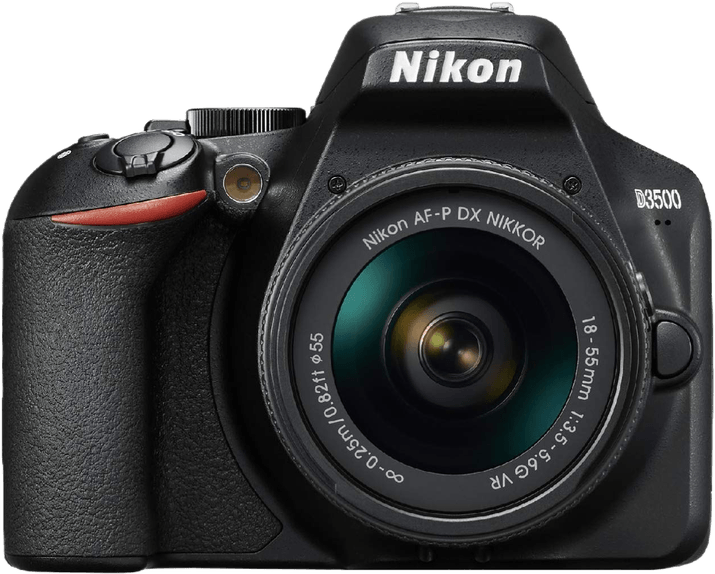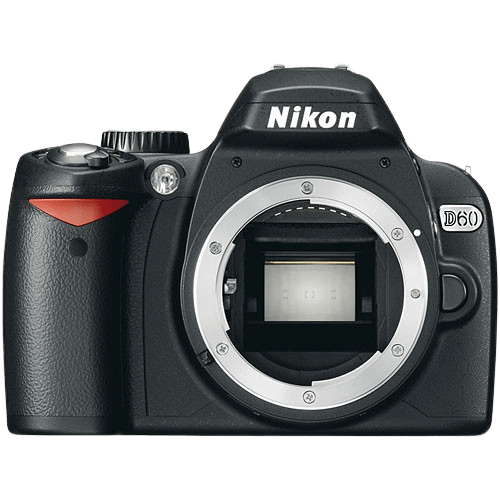Nikon D3500 vs D60 Comparison
Nikon D3500

Nikon D60

The Nikon D3500 outperforms the Nikon D60 with a notable score difference of 27 points, receiving a 61/100 compared to the D60’s 34/100. Both cameras share the DSLR camera type, but the D3500 was released a decade later in 2018, while the D60 was launched in 2008. The D3500 has a slightly larger body, measuring 124 x 97 x 70mm and weighing 615g, versus the D60’s 126 x 94 x 64mm and 522g.
The D3500’s higher score reflects its superior features and performance. It offers better image quality, improved autofocus, and enhanced connectivity options. However, the D60 has a lower launch price of $470 compared to the D3500’s $499.95, making it more affordable.
Despite the D60’s lower price, the Nikon D3500’s advancements in technology and performance make it a better choice for photographers looking for a quality DSLR. The D60 may appeal to those on a tighter budget, but the D3500 provides a more satisfying photography experience.
Nikon D3500 vs D60 Overview and Optics
The Nikon D3500 outperforms the Nikon D60 in optics with a score of 65/100 compared to the D60’s 43/100. Both cameras share some common specifications, such as an APS-C sensor size, Nikon F lens mount, and the absence of image stabilization. However, the D3500 surpasses the D60 in several aspects, making it the superior camera in terms of optics.
The D3500 boasts a higher resolution with 24 megapixels, while the D60 has only 10.2 megapixels. This difference enables the D3500 to capture more detailed and sharper images. Additionally, the D3500 has a faster shooting speed of 5 frames per second (fps) as opposed to the D60’s 3 fps. This feature allows the D3500 to capture fast-moving subjects with greater ease.
Furthermore, the D3500 utilizes a CMOS sensor and an Expeed 4 processor, which contribute to its higher DXOMARK score of 87. In contrast, the D60 employs a CCD sensor and an Expeed processor, resulting in a lower DXOMARK score of 65. The advanced sensor and processor in the D3500 provide better image quality and low-light performance.
On the other hand, the D60 has a Nikon F DX lens mount, which is specific to its camera series. This feature may appeal to photographers who own other Nikon DX cameras and wish to use the same lenses interchangeably.
Taking all factors into account, the Nikon D3500 excels in optics due to its higher resolution, faster shooting speed, and superior sensor and processor. While the Nikon D60 may have a slight advantage in lens compatibility for some users, it falls short in delivering the same level of optical performance as the D3500.
Nikon D3500 vs D60 Video Performance
When comparing the video capabilities of the Nikon D3500 and the Nikon D60, it is important to note that the Nikon D60 does not have any video functionality. Therefore, this comparison will focus on the video capabilities of the Nikon D3500.
The Nikon D3500 has a video score of 56 out of 100. It offers Full HD video recording with a maximum resolution of 1920×1080 pixels. The camera provides a maximum video frame rate of 60 frames per second, allowing for smooth and clear footage. However, the Nikon D3500 does not have built-in time-lapse functionality.
Given that the Nikon D60 does not have video capabilities, the Nikon D3500 is the clear choice for those seeking a camera with video recording features. The Nikon D3500’s Full HD video resolution and 60fps frame rate make it a suitable option for capturing high-quality videos.
Nikon D3500 vs D60 Features and Benefits
The Nikon D3500 outperforms the Nikon D60 with a feature score of 54/100 compared to the D60’s 17/100. Both cameras share common specifications, such as lacking a touchscreen, flip screen, GPS, and WIFI. However, the D3500 has advantages that contribute to its higher score.
The Nikon D3500 boasts a larger screen size of 3 inches, compared to the D60’s 2.5-inch screen. This difference allows for better image preview and menu navigation. Additionally, the D3500’s screen resolution of 921,600 dots surpasses the D60’s 230,000 dots, providing clearer and more detailed image display. The D3500 also features Bluetooth connectivity, which the D60 lacks, enabling wireless image transfer and remote control capabilities.
The Nikon D60, despite its lower score, offers some advantages over the D3500. The D60 is smaller and lighter, making it more portable and convenient for travel or extended use. However, these advantages are minor when considering the overall performance and capabilities of each camera.
The Nikon D3500’s superior features make it a better choice for photographers seeking higher quality image display and Bluetooth connectivity. The Nikon D60, while offering portability, falls short in comparison to the D3500’s capabilities and performance. Therefore, the D3500 stands as the preferable option between the two cameras.
Nikon D3500 vs D60 Storage and Battery
The Nikon D3500 outperforms the Nikon D60 in storage and battery with a score of 48/100 compared to the D60’s 27/100. Both cameras have one memory card slot and do not support USB charging. They accept SD and SDHC memory cards, but the D3500 also accepts SDXC cards, providing more storage options for users.
A significant advantage of the D3500 is its battery life, offering 1550 shots per charge using the EN-EL14a battery type. The D60, with its EN-EL9 battery, only provides 500 shots per charge. This extended battery life makes the D3500 a more reliable choice for longer shooting sessions.
The D60 has a slight edge in accepting MMC memory cards, which the D3500 does not support. However, this advantage is minimal as MMC cards are less common and less efficient than SD, SDHC, and SDXC cards.
Considering the extended battery life and broader memory card compatibility, the Nikon D3500 proves to be a superior choice in storage and battery performance compared to the Nikon D60.
Nikon D3500 vs D60 – Our Verdict
Are you still undecided about which camera is right for you? Have a look at these popular comparisons that feature the Nikon D3500 or the Nikon D60:

